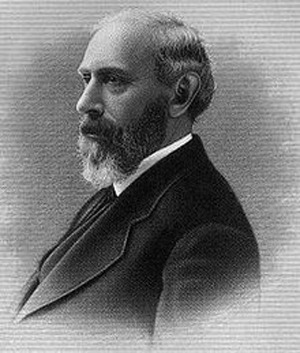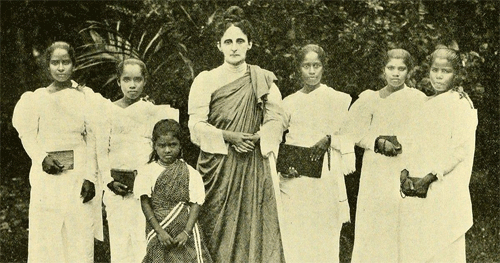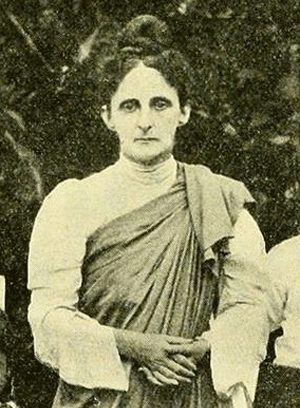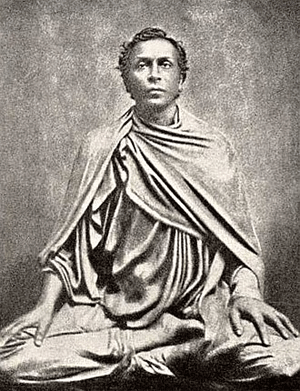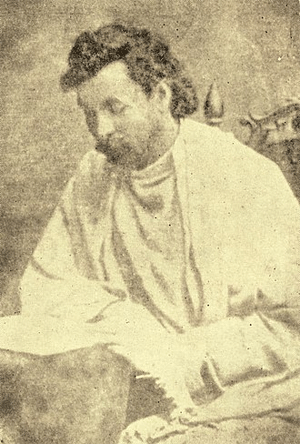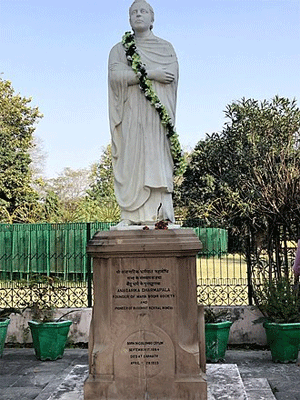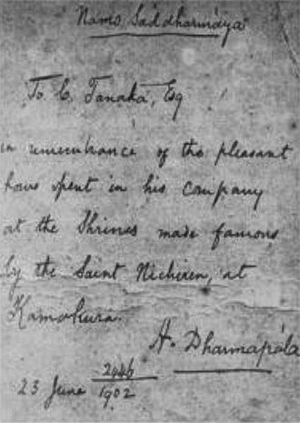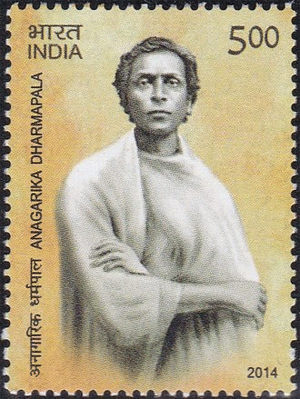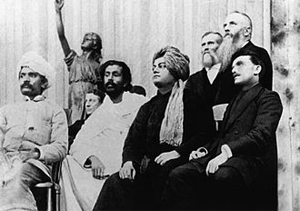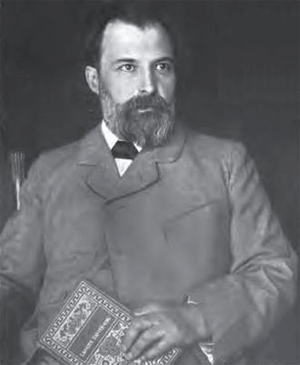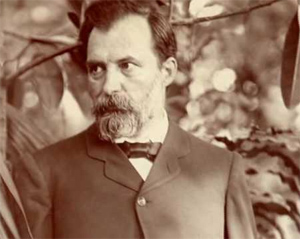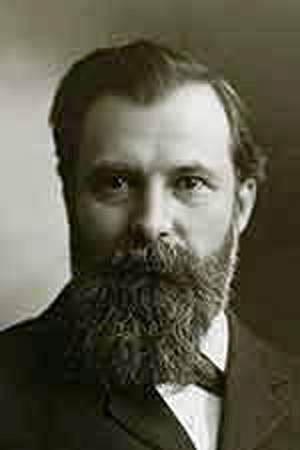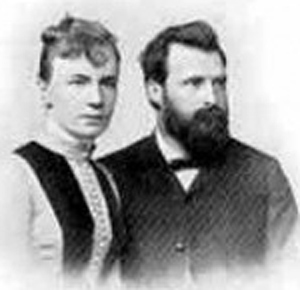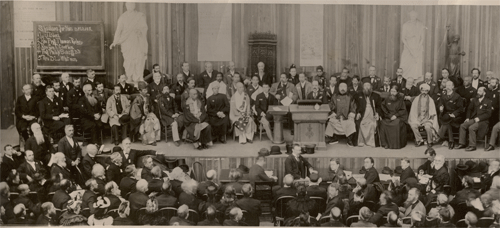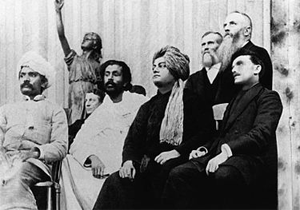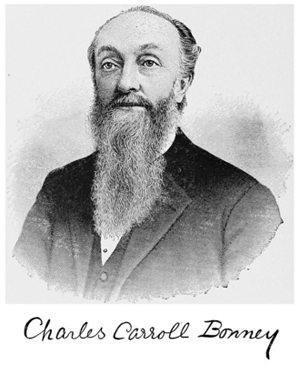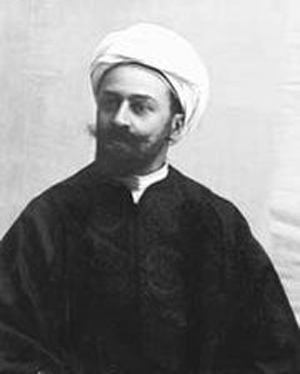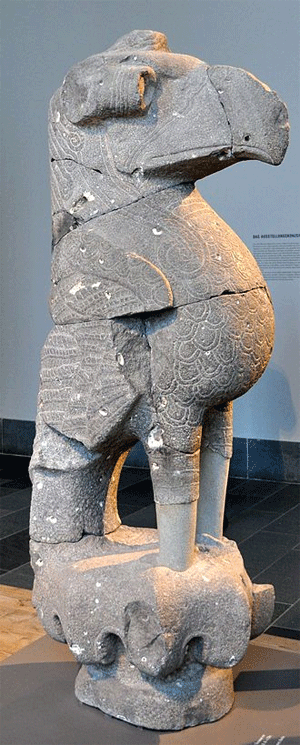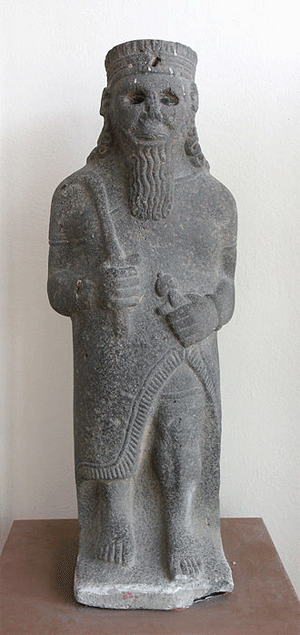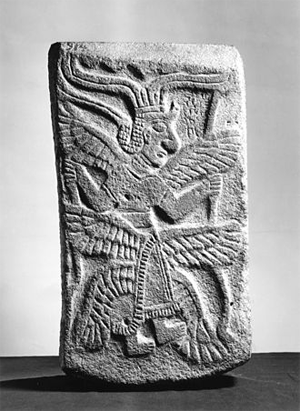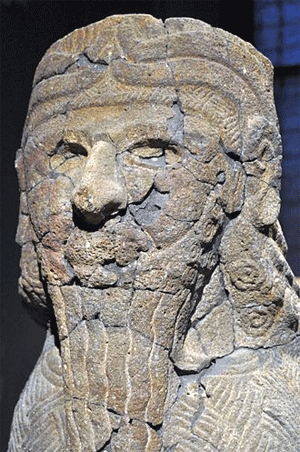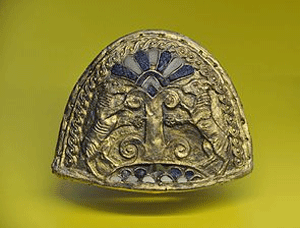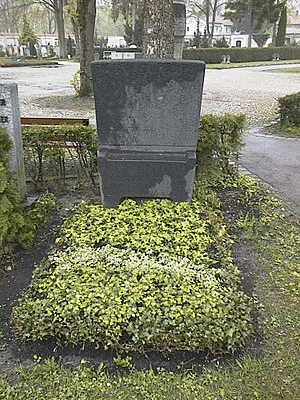3: Indian Revolutionary Movement in USA and Canada The Pan-Aryan Association
Excerpt from "Indian Revolutionary Movement Abroad" (1905-1921), by Tilak Raj Sareen, M.A., Ph.D.
1979
NOTICE: THIS WORK MAY BE PROTECTED BY COPYRIGHT
YOU ARE REQUIRED TO READ THE COPYRIGHT NOTICE AT THIS LINK BEFORE YOU READ THE FOLLOWING WORK, THAT IS AVAILABLE SOLELY FOR PRIVATE STUDY, SCHOLARSHIP OR RESEARCH PURSUANT TO 17 U.S.C. SECTION 107 AND 108. IN THE EVENT THAT THE LIBRARY DETERMINES THAT UNLAWFUL COPYING OF THIS WORK HAS OCCURRED, THE LIBRARY HAS THE RIGHT TO BLOCK THE I.P. ADDRESS AT WHICH THE UNLAWFUL COPYING APPEARED TO HAVE OCCURRED. THANK YOU FOR RESPECTING THE RIGHTS OF COPYRIGHT OWNERS.
In their efforts to extend the scope of their activities from the Continent to the United States of America the Indian revolutionaries in the initial stages had to overcome certain handicaps arising from the absence of a clear appreciation of India’s colonial situation. Though not downright hostile, the American attitude remained for a time indifferent towards the Indian political problem, an attitude which flowed more from a lack of communication than from anything else.
But once the aims and aspirations of Indians were made known through the agency of the Irish nationalists, the position started changing. There was then no looking back. Despite the anti-Asiatic feelings engendered by the rush of Indian immigrants to the Pacific Coast, the American people began to take keen interest in the activities of the Indian revolutionaries. Some of them even came into the open and joined the struggle on account perhaps of their own anti-colonial tradition, and of the historic suspicion of Great Britain as an exploiter of subject people.
The Indian immigrants, on the other hand, became a positive source of strength in terms of money and man power. On the Pacific Coast and Canada the Indian revolutionaries established within a few years a strong organisation, ready to challenge the might of the British in India. The US official response, no doubt, remained in favour of the British. Even so, the British Foreign Office had a tough time during the war to convince the US Government about the urgency of putting a check on the activities of the Indian revolutionaries. Its repeated representations had their effect, but by the time the US Government proceeded to fall in line with British suggestions by convicting Indians, an atmosphere of goodwill and understanding had already developed between the Indian revolutionaries and the American people, an understanding which was not to subside.
Before the arrival of the Indian immigrants the contact between the Indians and Americans had been nominal and sporadic. The earliest link was established by the Americans through trade with India towards the end of the 18th century. The merchantmen were followed by the American Christian missionaries, who played a prominent role in the development of American ties with India. On the Indian side the interest in America began with the coming of Madame Blavatsky and Colonel Olcott who founded the Theosophical Society in India in the early seventies 1 of the I9th century. Their visit to India gave a fresh impetus to the study of Hinduism and Indian culture in America. 2
The relationship between Americans and Indians holding advanced views was drawn closer by the visits of Vivekananda and other religious leaders to America.
The appearance of Vivekananda at the World Parliament of Religions in Chicago in 1893, created a new awareness about India. The voice of Swami Vivekananda brought to the Americans a realisation of the unsurpassed religious and philosophical legacy of India. It also began to awaken his own compatriots from the lethargy inculcated by foreign domination. 3 The visit also resulted in stimulating American interest in India and led to the welcome being extended (at least for some time) to Indian students as visitors to America. 4 The educational work carried on by the American missionaries in India also prepared the way for sowing of good seeds in a ready soil, the fruits of which turned the eyes of the educated Indians towards this new world. 5
When political unrest in India gained momentum after the partition of Bengal and the Swadeshi movement, interest in American political institutions received a fresh impetus and many Indian young men went to America, some at their own expense and others on money collected from those who held advanced views. They went to America apparently for scientific and technical education, but to quote the Director of Criminal Intelligence, “they had gone there to learn the manufacture of arms and explosives and to make a special study of the republican institutions and of the history of the struggle which enabled the Americans to throw off the British yoke.” 6 Historically and ideologically the Indian students were, no doubt, attracted to America for its revolutionary example in wresting independence.
This became clear with the publication of an article by H. S. Chima, under the heading “Why India sends students to America.” The main purpose, he wrote, of the Indian students in America, was to get ideal lessons in an ideal country, so that we may deserve the title educated, in the fullest and practical sense of the word. We come here to imbibe free thoughts from free people and teach the same when we go back to our country and to get rid of the tyranny of the rule of the universal oppressor (the British). 7
After their coming to the United States, most of the students became members of the Clan Na Gael and other Irish societies based in America. At the same time Shyamaji began propaganda for the Home Rule movement in the United States with the assistance of his Irish friends. Articles began to appear in the Gaelic American, an organ of the Irish nationalists, with the object of acquainting the American people with the state of affairs in India. The same paper gave a good deal of publicity to the ideas of Shyamaji and forcefully reminded the Indian people that in case they desired to prevent their further decline and demoralisation at the hands of the British, and if they also hoped to revive their former greatness, then they should struggle for attaining Home Rule on the lines laid down by Shyamaji. 8
The paper in a subsequent leader referred to the close cooperation which existed between the Indian and the Irish nationalists and their determination to carry on their war in alliance with Indian sentiments and sympathy against the common enemy. The writer further pointed out that so far as the influence of Gaelic American extends, it will be its duty to dissuade Irishmen anywhere from entering the services of the British Government in any capacity in India. The interests of all the countries held in subjection by the British are identical, for that reason, therefore, we hold out the hand of fellowship to the Indian people and promise them all assistance it is in our power to afford. India’s cause is also Ireland’s cause, they must march along the same road, and on the same lines to ultimate victory. 9
In subsequent issues also, the paper made a point of linking Ireland and India together as two downtrodden countries struggling for freedom and advocated the Russian methods to achieve it. The Government of India regarded the utterances of the Gaelic American as outrageous and a direct incitement to Indians to violence and intrigue to overthrow British rule. The Director of Criminal Intelligence recommended prohibition on the entry of the Gaelic American in India under the Sea Customs Act, but the Government declined to accept the suggestion as it would give “undesirable publicity to its writings.” 10
In another article, the Gaelic American stressed the importance as well as the necessity of the fight for the freedom of Ireland to be carried on in alliance with all those who were struggling against British oppression and decided to adopt the policy of concurrent action with the national movement then in progress in India. 10
Besides propaganda through the help of his Irish friends, Shyamaji sent his emissaries on a lecturing tour of the United States to acquaint the American people with the state of affairs in India. Dr Narayan Krishna, a graduate of Cambridge, was the first to go in 1906 to the United States with the object of informing the people of that country about the conditions of the people of India. 11
Taking their cue from Shyamaji, a few other Indians in the United States with the help of the Irish nationalists formed the Pan-Aryan Association in October 1906. The founder members were Barkatullah and S.L. Joshi; the former became its President and the latter Secretary. The association had the active support of George Freeman, John Davey and other Irish revolutionaries in the US. The object of the association was to bring India and America into closer contact and to be helpful to the students from India, to educate and send them back so that they could spread liberal ideas throughout the country. 12
With the cooperation of the Irish nationalists, the association started their anti-British propaganda and in a meeting held in New York resolutions were passed repudiating the right of any foreigner to dictate the future of the Indian people and urged their countrymen to depend upon themselves alone and especially on boycott and swadeshi. The meeting also condemned the deportation of Lajpat Rai and Ajit Singh. 13
Besides the anti-British propaganda, the association advocated the unity between Hindus and Muhammedans and the formation of a league between the peoples of Ireland and India for the overthrow of British rule. 14
The propaganda had its impact on the educated Americans. They started sympathising to some extent with the Indian national movement and some of them came into the open and formed societies to help Indian students and to give encouragement to their activities. The earliest society formed purely by the Americans was Indo-American National Association in September 1907. The founder was Myron H. Phelps, a Broadway (New York) lawyer. Many professors of American universities were associated with the Phelp’s movement which later functioned under the name of Society for the Advancement of India. The main objects of this society were (1) to assist Indian students in America, (2) to present Indian questions to the American press, (3) to secure facilities for Indians visiting America and for Americans visiting India, and (4) to convey the sympathy of Americans to the people of India and to help secure for them from the British Government a measure of self-rule. 15
Phelps came before the Indian public by contributing a series of letters to the Indian press in which he exposed the serious defects of the British administrative system and expressed the sympathy of the Americans with the Indian people. He also drew a parallel between the history of America, while still a dependency of Great Britain and that of India pointing out that in America boycott of British goods preceded the revolution and that Swadeshi was an American version of the boycott movement in the Indian situation, 16 which he anticipated would lead towards the overthrow of the British Government in India.
In the opinion of Kesari, Phelps' letters were a striking reply to the nervous moderate leaders who had been trying to frighten the nation into abandoning the boycott agitation and to sing the praises of their discredited mendicant policy. It advocated the adoption of Phelps’ advice and suggested that the boycott movement should be made more stringent. 17
Besides Phelps, other prominent Americans like W.S. Bryan and Andrew Carnegie also voiced the aspirations of new India and strongly criticised Britain for her policy of self-aggrandizement, and exploitation of the Indian people. 18
Lieut. W. S. Bryan company I, 27th Illinois volunteers, has had a sword and navy revolver presented to him, the former by the citizens of Kewanee, and the latter by Mrs. Lieut. Dow and Mrs. Lieut. Col. Burwell of Princeton. Lieut. Bryan is a Democrat of the fighting, traitor-hating kind.
-- Chicago Tribune, 3/9/1863
When it comes to activities by individual members, at first sight the pattern is confusing and superficially inconsistent. Let's give some examples:
• Andrew Carnegie profited from war through his vast steel holdings, but under the guidance of member Daniel Coit Gilman, Carnegie was also an enthusiastic president and financial backer of the American Peace Society. This is seemingly inconsistent. Could Carnegie be for war and peace at the same time?
• The League to Enforce the Peace, founded by members William H. Taft and Theodore Marburg, was promoting peace, yet active in urging U.S. participation in World War One. How could the League be for war and peace at the same time?
• In the 1920s, W. Averell Harriman was a prime supporter of the Soviets with finance and diplomatic assistance, at a time when such aid was against State Department regulations. Harriman participated in RUSKOMBANK, the first Soviet commercial bank. Vice-President Max May of Guaranty Trust, dominated by the Harriman-Morgan interests, became the FIRST Vice President of RUSKOMBANK in charge of its foreign operations. In brief, an American banker under guidance of a member of The Order had a key post in a Soviet bank! But we also find that Averell Harriman, his brother Roland Harriman, and members E.S. James and Knight Woolley, through the Union Bank (in which they held a major interest) were prime financial backers of Hitler.
Now our textbooks tell us that Nazis and Soviets were bitter enemies and their systems are opposites. How could a rational man support Soviets and Nazis at the same time? Is Harriman irrational or is the inconsistency explainable?
• The Bundy family (we have a Memorandum on them later) gives us another example of seeming inconsistency. William Bundy was with the Central Intelligence Agency for a decade. McGeorge Bundy was National Security Assistant to Presidents Kennedy and Johnson. So the Bundys presumably support U.S.-European policy which is pro-NATO. Yet the Bundys have been linked to activities and organizations which are anti NATO and, indeed, pro-Marxist -- for example, the Institute for Policy Studies. Are the Bundys inconsistent?
• Among individual members of The Order we find a wide variety of publicly proclaimed beliefs, ideologies and politics. William Buckley periodically chews out the Soviets. On the other hand, member John Burtt has been a member of a dozen communist front groups. Member William S. Coffin, Jr. spent three years with CIA and then became a leader of anti-Vietnam war activity through the National Conference for a New Politics and Clergy and Laymen Concerned about Vietnam. In fact, Coffin was one of the Boston Five charged and indicted for conspiracy to violate Federal laws. And, of course, W. Averell Harriman is elder statesman of the Democratic Party.
Quite a mixture of beliefs and activities. Do they reflect inconsistent philosophies? How can The Order have a consistent objective with this potpourri of individual actions?
The answer is, they are not at all inconsistent: because the objective of The Order is above and beyond these actions and in fact needs these seeming contradictions.
The State is Absolute
How can there exist a common objective when members are apparently acting in opposition to one another?
Probably the most difficult task in this work will be to get across to the reader what is really an elementary observation: that the objective of The Order is neither "left" nor "right." "Left" and "right" are artificial devices to bring about change, and the extremes of political left and political right are vital elements in a process of controlled change.
The answer to this seeming political puzzle lies in Hegelian logic. Remember that both Marx and Hitler, the extremes of "left" and "right" presented as textbook enemies, evolved out of the same philosophical system:
Hegelianism. That brings screams of intellectual anguish from Marxists and Nazis, but is well known to any student of political systems.
The dialectical process did not originate with Marx as Marxists claim, but with Fichte and Hegel in late 18th and early 19th century Germany. In the dialectical process a clash of opposites brings about a synthesis. For example, a clash of political left and political right brings about another political system, a synthesis of the two, neither left nor right. This conflict of opposites is essential to bring about change. Today this process can be identified in the literature of the Trilateral Commission where "change" is promoted and "conflict management" is termed the means to bring about this change.
In the Hegelian system conflict is essential. Furthermore, for Hegel and systems based on Hegel, the State is absolute. The State requires complete obedience from the individual citizen. An individual does not exist for himself in these so-called organic systems but only to perform a role in the operation of the State. He finds freedom only in obedience to the State. There was no freedom in Hitler's Germany, there is no freedom for the individual under Marxism, neither will there be in the New World Order. And if it sounds like George Orwell's 1984 -- it is.
In brief, the State is supreme and conflict is used to bring about the ideal society. Individuals find freedom in obedience to the rulers.
-- America's Secret Establishment: An Introduction to the Order of Skull and Bones, by Antony C. Sutton
Phelps’ purpose in launching the society, as interpreted by the Director of Criminal Intelligence, was to arouse the people in America, India, Ireland and England, by showing them that a united demand for justice was in the offing and if it was repressed, it would be followed by open revolution in India to throw off the foreign yoke. 19
The movement in favour of India in US received further impetus from the visit of Madame Cama as an emissary of the Indian revolutionaries from London and Paris. Arriving in New York in October 1907, Madame Cama delivered a series of lectures before American audiences, explaining to them the purpose of her visit. “I am in America”, she said, “for the sole purpose of giving a thorough expose of the British suppression which is little understood so far away and to interest the warm hearted citizens of the great Republic” in our fight for freedom against the British rule. 20 Explaining the aims of the Indian revolutionaries abroad she made it clear that it was to achieve “Swaraj; self-government” and to strive for “liberty, equality and fraternity” with the hope of getting it within ten years.
When questioned by a press correspondent as to “how this mighty overthrow was to come about,” she explained, “by passive resistance. We are peaceful people and unarmed. We could not rise and battle if we could. We are preparing our people for concentrated resistance.” 21
In the subsequent meetings, which Madame Cama addressed at the Minerva Club and at the Adams Union Theological Seminary, she asked for the help of the American people for the political enfranchisement of India. Her only regret was that the American people had knowledge about the conditions in Russia, but they had no idea about the conditions in India under the British Government. 22
It was on account of her visit and her meeting with Barkatullah and Phelps, that both the societies decided to join in 1908 and worked together for self-rule for India. 23
The ruthless policy of the Government of India to suppress the rising tide of the national movement gradually convinced Indians abroad that it was futile to carry on the struggle on constitutional lines. Madame Cama in Paris and Savarkar in London started advocating violent methods for the attainment of freedom. Their propaganda had a direct impact on the political thinking of the Indians in America. This had already been noticed by the British Consul-General. He reported that the Indians were saying in private that they had been trying for the last twenty-one years to obtain freedom by constitutional means and were now tired of that line and that their difficulty, however, was the same as that of the Irish; they had no arms. 24
An “India House” similar to that of London, was established in New York where Indian interests were to be concentrated and where Indian students and visitors from India were to find warm welcome and a comfortable room at a moderate cost. 25
Morley was beginning to sense that a tide of strong public opinion favouring self-rule for India might one day sweep the United States, a tide of the same kind as had swept public opinion in England respecting Austria, Russia and Turkey. He had even informed Minto after receiving reports from Bryce, the British ambassador, who in his turn had some uneasiness in this direction and had reminded that a German Official was sending a story of the same sort to his Government. 26
Morley’s letter to Minto caused considerable disquiet to the Government of India. Their fears were further augmented by the reports of the Director of Criminal Intelligence, who wrote that the United States was becoming a place of refuge for the young revolutionary Indians from the Continent and India. There were various reasons for the flight of the Indian revolutionaries to the United States. According to her, personal assistant to the Director of Criminal Intelligence, Europe did not prove to be a conducive place for their activities because there they were treated with suspicion and were not readily admitted in ammunition factories or technical institutions. On the contrary, the United States gave ample scope for the distribution of revolutionary literature which was prescribed in India, while in London and Paris the Indian revolutionaries were kept constantly under the careful watch of the British detectives. Besides in the United States, there were Irish nationalists ready to take up any movement likely to embarrass the British Government. 27 In addition to the above, the Indian revolutionaries had by then awakened the sympathy of a section of the American people and their interest in India flowing perhaps from their own “anti-colonial tradition and historic suspicion of Great Britain as an exploiter of the subject people.” 28
After seeing the alarming reports Minto asked Morley to employ “a good lecturer thoroughly well-up in Indian affairs who could appear on the public platform” in the United States and explain the Government of India’s point of view regarding their administration in India. Minto did not favour Morley’s suggestion for sending copies of the Government of India’s reports to the British Ambassador in America for distribution in that country to counter the propaganda of the Indian revolutionaries. 29
Though the agitation in favour of self-rule carried on by these two societies gained them the support of the Americans, yet the policy of the United States’ Government was still favourable towards British rule in India. President Theodore S. Roosevelt had great faith in the efficacy of British rule and found in the “most colossal example history affords of a successful administration by men of European blood of a thickly populated region on another continent.” In his view the successful administration of the Indian Empire by the English has been one of the most admirable achievements of the white race during the last two centuries. The mass of the people have been and are much better off than ever before and far better off than they would be if English rule was overthrown or withdrawn. 30
These flattering views of the President cheered the British rulers, but discouraged the advocates of the Home Rule movement. 31 Morley was happy on this pronouncement of the President and informed Minto that it had been of undoubted material advantage for them. 32 It is believed that Roosevelt openly praised the British rule in response to the appeals of his British friends. 33 Whatever might have been the reasons, his speech in defence of British imperialism did not go unchallenged. Phelps and other members of the Society for the Advancement of India sent an open letter refuting his views. 34 In India also his speech came under a lot of criticism. The press considered that the American President should have refrained from proclaiming from the house-top one-sided judgement for the enlightenment of the world. 35 Another newspaper commented that while boasting of the philanthropic mission of the Whites, the President had completely or rather deliberately ignored the miseries to which the indigenous races had been subjected by the inroads of the Whites in India. 36
Both the India Office and the Indian Government took a lenient view of the Indian revolutionary movement in the United States when they came to know of the departure of Phelps for Europe, of Joshi for India and of Barkatullah for Japan in the beginning of 1909. 37
The departure of these people slowed down the progress of the movement. But the Indian students now thoroughly imbued with nationalist feelings were bitterly opposed to the British rule in India and never lost an opportunity of enlisting American sympathy against the latter. After having come under the influence of the socialistic and revolutionary ideas, they regarded it as their mission in life to work for the subversion of the British rule in India. 38 Besides this trend amongst the student community, the Indian national movement developed more quickly amongst the Indian labourers who were settled on the Pacific Coast under slightly different circumstances.
Indians on the Pacific Coast
As compared to the students, the Indian labourers who emigrated to America in the early years of the century for economic betterment met with a strong opposition. The emigration of Indians began in the year 1904 and reached a high proportion during 1905-06. In the United States, the Indian emigrants were confined to the three states on the Pacific Coast, viz., California, Oregon and Washington. The Indian emigrants came to the United States indirectly, that is, as a result of discrimination in Canada. Here also they were subjected to the prevalent anti-oriental bias of the Pacific Coast States. 39
From the very beginning the Indian emigrants met with a strong hostility from the white labourers and in the wake of the economic crisis of 1907 it developed into a widespread anti-Indian movement. Conflicts became common between Indian and white labour, eventually leading to the violent expulsion of the former from the mills at Bellingham in the state of Washington and from other places in the United States.
The British Ambassador was unwilling to intervene on behalf of the Indians. He took pains to explain the difficulties in the way of securing the immunity of these British subjects from interference in their employment or even from violence. 40 While referring to several serious instances of coercion which had been reported after the occurrence at Bellingham he pointed to the inefficacy of diplomatic intervention on their behalf which was seriously “prejudiced both by the relations between the Federal and State authorities” and by the fact that the Treaty of 1818 which regulated the “rights of the British subjects in the U.S.” could not be “appealed to on behalf of British East Indians*’ as it was applicable only to the inhabitants of His Majesty’s territories in Europe. 41
The emigration to America soon, however, fell off as the American immigration policy became one of selection at first, restriction later and finally of exclusion. This was the case especially with the Indian labourers though the United States authorities were quite liberal towards students and professional and leisured classes. Legally, the Indians were not excluded from entering the United States, but the Emigration authorities devised certain measures by which they could keep the Indians out. Every Indian was put under various tests such as freedom from disease, capacity for self-support, likely to become public charge, which were applied with the deliberate object of deciding against the emigrants in most cases. 42
However, opposition to Indians was nominal as compared to the anti-Japanese sentiments on the Pacific Coast. At the same time, the conditions of the Indian labourers assumed serious proportions in Canada, where they had also emigrated in 1904. Between 1904 and 1908 about five thousand Indians went to Canada. 43 The basic reason of Indian emigration to Canada was economic: Canada, especially British Columbia with its natural resources and sparse population, offered great opportunities to the Indian labourers. The first group of Indians crossed over to Canada about 1904 from Hong Kong having heard much about the wealth in Canada. On arrival they found bright prospects in the wages then current and sent reports to their relations and friends in India and the Fiji Islands which resulted in a rush to Canada. 44
The subsidiary causes leading to their emigration in large numbers in subsequent years were that the steamship companies and their agents in India offered cheap transportation to those who were willing to go there. These private companies gave a great deal of publicity in the rural districts of India to the opportunities of fortune-making available in British Columbia. 45 The majority of the emigrants came from the Punjib and nearly seventy-five per cent of them were Hindus from the districts of Ferozepore, Jullundur, Ludhiana, Amritsar and Lahore and some also from the princely State of Patiala. The rest of the twenty-five per cent were Punjabi Mohammadans. 46
The emigrants mostly came direct from India, but some of them came from Burma, Shanghai, Hong Kong and other places in the Far East, where they had been working as policemen or watchmen. In the beginning, they met with sufficient encouragement. Manual labour was scarce and wages were high in British Columbia and a supply of able-bodied Indians ready to work well for a moderate wage and giving no trouble in the matter of trade union rules was quite beneficial for the white employers. 47 But soon after working hard when the Indians settled down to a comfortable living, their main troubles started. Their advent was vehemently opposed by the white labour groups, whose hostility was the outcome of the fact that it had greatly affected their chances of employment. They started a campaign of “calumny and vituperation against them.” In their anti-Indian movement they were encouraged by the local politicians who were eager to maintain the white labour's vote. The British Immigration Agent, Colonel Falk Warren reported the anti-Indian feelings in Canada and suggested that some provision might be made to meet the situation as strong efforts were on foot by the people in British Columbia to prohibit the entry of the Indians into Canada. His own belief was that it was “very improbable that such a discrimination against British subjects” could be allowed, but in order to avoid the developing crisis he proposed that “immigration from British India might be restricted or regulated.” 48 The British Agent’s report was followed by a despatch from the Canadian Government who asserted that the presence of Indians excited the Canadian people to fury and it was probable that violence would be re- sorted to if nothing was done to restrict future immigrants. 49 They showed their unwillingness to perform the disagreeable duty of enforcing the law against their own people and to protect the interests of the Indians in case adequate steps were not taken to prevent their coming to Canada in large numbers. 50
The Government of India, confronted as it was with the problem of internal unrest 2nd violent agitation and in view of the state of public feeling in India as to the injustice with which Indians were being treated in Canada, the United States and South Africa, were reluctant to take any serious notice of the warning from the Canadian authorities and to restrict Indian emigration to Canada. But the problem of oriental immigration to Canada became so acute that the Canadian Government appointed a Royal Commission in 1908 to report on the matter. The Commission recommended the exclusion or restriction of oriental labour including Indians and considered it a natural desire of Canada to control the immigrants from the orient. Canada’s wish to remain “a Whiteman’s colony” was regarded by the Commission “to be not only desirable for economic and social reasons, but highly necessary on political and national grounds.” 51
The Commission particularly referred to the unsuitability of Indians for settlement in Canada on account of their objectionable manners and customs so unlike those of the people of Canada. 52 Before the introduction of any measures, W.L. Mackenzie King, Deputy Minister of Labour, was sent to London in 1908 to discuss with the British Government the problem of Indian emigration to Canada. The outcome of the secret discussions which took place at the India Office was that Morley, Grey and Elgin agreed that a “self-governing colony like Canada” could not “be prevented from making regulations to exclude or restrict Asiatic immigration. ” 53
With the tacit approval of the British, the Dominion Government issued orders-in-council in May 1908 prohibiting the landing of immigrants unless they came direct from their country of birth or citizenship on through tickets purchased before starting. 54 Morley sounded Minto about this decision of the Colonial Government who were desirous “in the interest of the empire of avoiding any appearance of social discrimination” and had accordingly decided to insist on this rule which was likely to “render it impossible for any Indian to enter Canada” and requested him to “take all possible steps to discourage efforts at such immigration’' 55 from India.
The “continuous journey” order was soon followed by another order-in-council in June 1908 prohibiting the entry into Canada of all Asians other than those who had two hundred dollars in their possession at the time of landing. 56 These orders resulted in creating an effective barrier for Indians to enter Canada since there was no direct steamship service between the two countries and very few Indians could afford to have two hundred dollars in their possession. It is generally held that the policy of exclusion of Indians from Canada “originated through British initiative” and that “the Canadian authorities, with the approval of the British Government in England and possibly with the sanction of the India Office” 57 restricted the immigration of Indians. From the evidence available it seems very doubtful whether the India Office took any initiative in suggesting the idea of a “continuous journey” clause for the exclusion of Indians. However, it is a fact that neither the India Office nor the Government of India raised any objections to these orders. On the contrary, they “complimented the Dominion Government on the conciliatory attitude displayed by them in dealing with the question of Indian immigration.” 58 The Government of India, however, did not agree to the proposal of the Canadian Government for placing restrictions in India on Indian emigration but it gave its unfeigned approval to the Dominion Government to take such measures as were necessary “to restrict immigration into their territories.” 59
The Indian newspapers strongly protested against these laws of Canada and some wrote frankly that “if the Canadians want to debar the Indians from entering Canada, it is highly necessary that they in their turn should be debarred from entering India.” 60
These humiliating restrictions apart, another equally objectionable scheme was devised by the Canadian Government for the deportation to British Honduras of Indians already settled in Canada. However, before the scheme was implemented a delegation of representative Indians was sent to Honduras to study the conditions there. They advised their countrymen to reject the proposal since it was a wholly unsuitable place, “climate and economic conditions being unfavourable.” 61 In view of the strong opposition from the Indians, the scheme was dropped.
The harsh treatment to which the Indians were now subjected both in Canada and on the Pacific Coast aroused in them a feeling of resentment against the British Government which apparently was not willing to safeguard their rights as citizens of the Empire. However, it appears more plausible to say that the exclusion of the Indians from Canada and the United States was largely due to the influence of the Home Government and that it was imperial policy to keep the Indians at home in order to prevent them from acquiring ideas of political liberty.
The common need of protection against the hostility of white labour brought the Mohammadans, Sikhs and Hindus from the Punjab and Brahmans from lower Bengal together in a way that could not have happened in India. The Indian emigrants had not gone to Canada to permanently settle there, but to accumulate money and return to India to free their land from mortgage or to purchase new land. 62 But while living in Canada and the United States, they realised their humiliating position. After having come in contact with free people and free institutions, there dawned in their minds the value of liberty. The burning shame of having been born in a slave country made them appreciate all the more strongly the worth of freedom. Out of their sense of national humiliation and their newly acquired ideas of democracy came a new awakening. This new awakening was further fostered by the preachings of the educated Indians, who had formed a number of societies with the aim of defending the rights of their countrymen as citizens of the British Empire.
The earliest known society, the “Hindustan Association” was established in 1907 by Ram Nath Puri, Tarak Nath Das, Pandurang Khankhoje and others in San Francisco with branches at Vancouver and Astoria. The association brought out a periodical in Urdu Circular-e-Azadi (Circular of Freedom). The association aimed at imparting instructions to Indians on national lines and also to teach them the use of arms and other weapons for self-defence and to foster American sympathy with India. The Association looked after the well-being of the Indians, but from its very inception it started inculcating in them the ideas of driving the British out of India by violent means. Several hundred copies of the Circular-e-Azadi were also sent to India. However, on account of the opposition from some of its members who did not like the rash methods or such open expression of the means of ridding the people of India of British rule, 63 Puri had to discontinue the paper. Its importation into India had already been prohibited on account of its seditious writings. Besides the lukewarm cooperation from the Indians, the constant pin-pricks from the police forced Puri to leave the United States. He made his way to Japan where he worked with Barkatullah. The work of the Association, however, was taken over by Tarak Nath Das (1884-1958), a young Bengali, formerly associated with the Vancouver branch of the Hindustan Association as its treasurer. With the termination of Circular e-Azadi Das brought out another revolutionary paper Free Hindustan, Das had the requisitive training as a revolutionary. While in Calcutta he had taken a prominent part in the political agitation and was one of the founder-members of the Anusilan Samiti, a secret revolutionary society. Leaving India about 1906 he first went to Japan and then proceeded in the same year to San Francisco and joined the University of California at Berkeley. In January 1906, he worked for sometime with the United States Immigration Office at Vancouver. 64
The Free Hindustan was in general appearance and tone of its writing quite similar to the Indian Sociologist of Shyamaji. On account of its strong anti-British propaganda a representation was made by the Dominion Government to Washington referring to the unfriendly attacks made upon British prestige in a paper published by an interpreter in their employment. As a result of this Das resigned from service. 65
After his resignation. Das devoted all his time to the propagation of the nationalist ideas amongst his countrymen. A school at Mill Side, New Westminster, was opened where lectures were delivered on subjects connected with unrest in India and the unfair treatment of Indians in Canada and USA. Das denounced fearlessly the repressive measures which the Government of India was resorting to “crush the national aspirations of the people.” Like Shyamaji, he also reminded the people that there were two paths open to them: one of eternal servitude to an alien people and a consequent annihilation of their life as a nation and the other of a glorious existence as an independent nation. His only advice to them was to shake off the first and follow the second path. 66
Under Das’s selfless devotion and leadership the constitution of the Hindustan Association was revised. Its ambitious object now was to “establish liberty, equality and fraternity of the Hindustan nation” in her “relation with the rest of the nations of the world.” All the members of the Association were enjoined to gave up prejudices of caste, colour and creed. 67 Like the Indian revolutionaries in London and Paris, with whom Das was in close touch, he also believed in creating a revolution in India, but was not sure whether the people in India had “a desire and the power to create it." The primary necessity he considered was to arouse national spirit in the mass of the people of India and to "make them understand the need of national independence." He attached more importance to the establishment of revolutionary organisations not only in British India, but all over India. Being more practical in his outlook he regarded the solitary acts of assassination of the British officials as not adequate to attain the goal which could only be achieved by an organised uprising. 68
The majority of the Indians on the Pacific Coast were slow to fall under the spell of the violent propaganda of Das, they listened more readily to the preachings of his associate Teja Singh, a tireless Sikh leader and secretary of Khalsa Diwan Society established in 1907 with its headquarters at Vancouver, which concentrated mainly on the religious and economic interests of the Sikhs. Another Sikh organisation having similar aims was the Pacific Coast Khalsa Diwan Society formed at the same time. 69
Teja Singh belonged to Amritsar and had studied at Cambridge and Oxford. He went to England in 1906 and was in New York in 1908. In England, he came under the influence of Shyamaji and Rana and while in New York he associated with Phelps and Bhupendranath Datta. From New York he went to Vancouver with the aim of bringing about a regeneration amongst the Sikhs. In Vancouver, he took part in the labour agitation and was a representative of the Sikhs in a delegation to the Honduras. Through lectures and propaganda in the press, Teja Singh ventilated the grievances of the Sikhs in Canada. After his second visit in 1909 to England he started the agitation against the British more vigorously, and with Das, established an ‘India House’ at Berkeley. 70
Another prominent worker in Canada was Gurudutt Kumar who also started publishing a paper Swadesh Sewak in Gurmukhi. 71 The paper gave wide publicity to the grievances of the Sikhs arising out of the restrictions imposed on them by the laws of Canada and inspired them to fight for their rights. He was a frank and bold champion of the rights of the Indians in Canada for which he frequently came into collusion with the authorities.
Despite the various Indian organisations, the conditions of the Indians in Canada began to deteriorate when more stringent measures were introduced. At first the Indians adopted the constitutional policy for the redress of their grievances by petitioning to the Canadian Government. The first petition was sent in 1911. In response to the petitioning policy of the Indians, the authorities responded with more strict laws. The Indians approached the Secretary of State for India and the Viceroy and sent copies to the Indian national leaders with a request to seek the cooperation of the Indian Government for the removal of the restrictions imposed on the British Indian subjects coming to Canada. 72 Besides the laws already in existence, the Canadian Government then decided not to allow the Indians to bring their wives and children from India.
In 1911 a deputation of Indians went to Ottawa to represent their grievances to the authorities but without any success. Later on the deputation came to India also but nothing fruitful came out of it. The problem reached a crisis when the Immigration authorities refused to admit the wives of two respectable members of the Sikh community at Vancouver, Bhag Singh and Balwant Singh. After prolonged negotiations and propaganda the authorities relented and allowed them to land “as an act of grace.” Subsequently the attempt at exclusion formed a strong basis for an agitation against the inhumanity of separating husbands from their wives and children. Another factor which increased the discontent amongst the Indians was the lenient treatment which was then being accorded by the Canadian Government to the Japanese and Chinese emigrants as compared to the Indians. 73 But this act of grace did not satisfy the demands of the Indians who actively started taking interest in different associations. This atmosphere provided an excellent opportunity to the political leaders to proceed earnestly to indoctrinate their countrymen with political ideas. The results were soon visible in the large attendance at meetings. In the absence of any coordination between the different associations the political propaganda was not very effective. G.D. Kumar, Tarak Nath Das, Bhag Singh. Balwant Singh, Hari Chand Suri and Seth Hassan Rahim were some of the active leaders in Canada who were trying to give the movement a definite shape, but they had failed. Kumar had been constantly appealing to the people to forget the nominal distinction, and “be all united into one strong body of the East Indians” 74 but with no appreciable success.
In 1911 the Indian revolutionaries in Paris, while formulating a scheme of bringing about a successful revolution in India, had taken serious notice of the haphazard growth of the movement on the Pacific Coast, where too many societies had sprung up. 75 To consolidate it into a strong movement against the British Government Har Dayal proceeded to America. 76 Besides Har Dayal Indian revolutionaries in Paris also sent Thakur Das in August 1911 to America on a mission to preach revolutionary ideas “amongst the Sikh brothers on the Pacific Coast.” 77 Kumar immediately propagated the arrival of Har Dayal, who was on a special mission to organise the Indians. Kumar expected that under Har Dayal the people might be “united into one organisation leaving aside the ideas of provincialism.” 78
Har Dayal landed in the United States in January 1911 and with his arrival began a new chapter in the history of the Indian revolutionary movement in the United States.
Har Dayal and the Formation of the Ghadr Party
Har Dayal (1884-19391 son of Lala Gauri Dayal, born in 1884 was educated at St. Stephen’s College, Delhi, and Government College, Lahore. On account of his distinguished academic career, he was awarded a scholarship by the Government for studying at Oxford, but in 1907 after having come under the influence of Shyamaji’s propaganda, he resigned his scholarship saying that no Indian who really loved his country ought to compromise his principles and barter his rectitude for any favour from the alien and oppressive rulers of India. While as a student, a sense of revolt at the dependent position of Indians as a nation had taken deep root in his mind. In England he actively associated with the Home Rule movement of Shyamaji and there blossomed forth as a complete nationalist. 79 He came back to India in the beginning of 1908 and joined the ranks of the extremist leaders. He endeavoured to spread the doctrine of active hostility to the British by advocating the boycott of the British Government at educational institutions and even asked the young lawyers in the Punjab not to work as pleaders because that also amounted to helping the Government. At that time, the extremist leaders of the Punjab had neither the courage nor the inclination to fall in line with his views. Gradually his anti-British propaganda and writings began to attract the attention of the Government and it was feared that the Government would soon find some excuse for putting him behind the bars, so he decided to leave the country. 80 In 1908 he came to Paris with the aim of carrying on the movement from outside for the emancipation of India and worked with Madame Cama and others for some time. In Paris he edited the Bande Mataram, but it appears that he could not pull on well with other Indian revolutionaries, especially Shyamaji, and left for America towards the end of 1910. 81 After his arrival in California, he worked as a lecturer in Indian Philosophy and Sanskrit at the Leyland Stanford University. Although he was doing the work of a regular professor, he did not accept any remuneration 82 from the university. But soon thereafter he left the university, and turned his attention to organising the national movement on the Pacific Coast. While in Europe, Har Dayal had formulated his ideas and thought over the work which he intended to do in America. He belonged to that group of fearless Indians who were struggling to achieve the freedom of their country by organised rebellion and if possible by tampering with the loyalty of the Indian Army. He had been rather too frank in explaining the way in which he wanted to proceed with the object of bringing about a revolution in India and had come in clash with other Indian revolutionaries in London and Paris. A believer in secret or direct methods, Har Dayal could not support the policy of individual assassinations. He observed that “half measures are of no use. They blind the people to the mighty issues that are at stake. We must lay the axe at the root of the tree. The people can never understand the figment of loyalty to a sovereign and hostility to the Viceroy. This is a European conception, which cannot be assimilated by us.” He staunchly believed that it was better to place a clear issue before the people. “Plain speaking,” he considered “carries conviction to the heart, while sophistry only perplexes honest men. This is one of the reasons why Congress has failed to appeal to so many people.” 83
Still relying upon his old convictions and ideas, Har Dayal began the difficult task of organising the movement and followed them vigorously and later events showed that he was not altogether unsuccessful in his efforts. After resigning from the Stanford University he went to Berkeley where he established a students’ club and delivered lectures with the avowed object of creating in them anti-British feelings. Following the example of Shyamaji he also made efforts to give scholarships to Indian students and widely advertised them in India with the hope of attracting a large number of them to the Pacific Coast. 84
While Har Dayal was engaged in reorganising the movement according to his ambitious ideas, his presence was immediately reported by the British Agent, W.C. Hopkinson. He considered that of all the political agitators, who had come to the United States, Har Dayal was the most dangerous and it was unfortunate that he had established his centre at Berkeley among the Indian students attending the University of California, where he was bound to wield a great influence on the young. He advised the Indian authorities to utilise the good offices of the United States Immigration Service (Department of Trade and Commerce) to get rid of Har Dayal. 85 With hardly any concrete evidence, Spring-Rice, the British ambassador was reluctant to encourage the representation against Har Dayal to the authorities in the United States. The Government of India though discouraged by Spring-Rice sent some Bluebooks to Tilton Steele, an Anglo-Indian Assistant to Hopkinson, for delivering lectures refuting the charges made by Har Dayal in his propaganda.
From Berkeley, Har Dayal applied his mind towards the deplorable condition of the Indian labourers on the Pacific Coast and Canada. During the tour of these areas Har Dayal, accompanied by Khankhoje, 86 delivered a series of lectures. Wherever he went, people listened to him enthusiastically and his popularity grew rapidly. The restriction imposed on Indian immigration was the main topic of discussion and Har Dayal fully utilised the discontent amongst the Indians generated by these harsh laws against the Government. 87 Gradually Har Dayal won the support and confidence of his countrymen. The two main organisations, the “Hindustan Association” of the United States of America mainly composed of the students and the “Sikh Khalsa Diwan” readily responded to the appeals of Har Dayal and decided to give him their full support. He also contacted prominent leaders in Canada with the aim of organising them under one single party. After having achieved this remarkable success Har Dayal thought of calling a convention of all the Indian revolutionaries abroad in 1914 and expected that the most ardent political workers from India, France, Switzerland and England would attend with a view to formulate a common scheme for the emancipation of India. This Har Dayal could not achieve on account of later developments which made his stay in the United States an impossibility. It appears from the report of the British Agent that in a short time Har Dayal succeeded in winning the cooperation of the main organisations of the Indians on the Pacific Coast and Canada. 88 A meeting was convened at Astoria on 2 June 1913. attended by the delegates representing different organisations from St. John, Portland, Bridel Veil and many other places. In this momentous meeting Har Dayal convinced the delegates about the urgent necessity of organising a single association which could safeguard their interests more effectively. The proposal met with an enthusiastic response and they agreed to the suggestion of Har Dayal to name their association as “The Hindi Association of the Pacific Coast.” 89 Further resolutions were passed regarding the working of the Association. The party was to publish its own weekly paper, entitled the Ghadry in memory of the mutiny of 1857. The head office of the Association at San Francisco was to be known as Yugantar Ashram or New Era Society. No person was “to get any pay for doing work in the office of the Association or in the Newspaper,” however, he was to be given some maintenance allowance from party funds. Every worker joining the party was required to contribute one month’s pay towards its funds. No religious discussions were to be allowed in the meetings of the party and there was to be an annual election of the office-bearers of the party. 90
The aim of the Association was the overthrow of the British Raj in India and to substitute in its place a national republic based on equality and freedom. The Association wanted to achieve this by an armed national revolution. Every member was declared to be honour and duty bound to participate in the fight against slavery carried on anywhere in the world but especially to crush the British Imperialism. 91
In addition to the office-bearers an organising committee of most of the founding members and a commission of three persons for doing secret and political work were constituted. The three members were Har Oayal, Kanshi Ram (1883-1915) and Sohan Singh Bhakna (1870-1968). Kartar Singh (1896- 1916) Harnam Singh and Jagat Ram were deputed to assist Har Dayal in bringing out the Ghadr. 92
By his devotion and tireless efforts Har Dayal was able to collect sufficient funds for establishing an independent press in San Francisco for the publication of the Ghadr, the first issue of which came out on 1 November 1913. 93 The appearance of this paper gave the association its more popular name “The Ghadr Party.” The paper from its very inception intended to arouse the national self-respect of Indians by perpetually emphasising the fact that they were not respected in the world as they were not free. The name of the party was changed later to “Hindustan Ghadr Party” to make it clear that the organisation did not advocate revolution in the United States. 94

